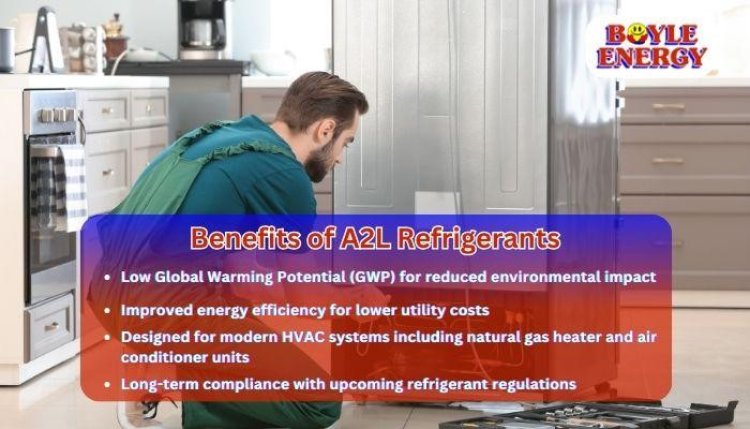Why A2L Refrigerants Are the Future of Eco-Friendly HVAC Systems
Share this Post to earn Money ( Upto ₹100 per 1000 Views )

Introduction:
The HVAC (Heating, Ventilation, and Air Conditioning) industry is at a turning point as more homeowners and businesses prioritize sustainability. A major innovation leading this shift is the adoption of A2L refrigerants — a new class of low global warming potential (GWP) refrigerants that combine energy efficiency, safety, and environmental responsibility.
From residential homes to commercial buildings, HVAC systems using A2L refrigerants are becoming the standard. Whether you're upgrading to a more efficient natural gas heater and air conditioner or installing a new system from scratch, understanding A2Ls is crucial.
What Are A2L Refrigerants?
A2L refrigerants are specially formulated chemicals used for cooling and heating in HVAC systems. They belong to a category defined by the ASHRAE safety classification system, where:
-
"A" stands for low toxicity
-
"2L" indicates low flammability and slow burning velocity
This combination makes A2Ls both safe and efficient. Common examples include R-32 and R-454B, which deliver similar performance to older refrigerants like R-410A — but with a dramatically lower environmental footprint.
Why A2Ls Are Replacing Traditional Refrigerants
The move to A2L refrigerants is driven by both environmental needs and global regulations. Traditional refrigerants, such as R-22 or R-410A, have high GWP ratings, which means they contribute significantly to climate change when leaked into the atmosphere.
In contrast, A2Ls offer:
-
Lower environmental impact
-
Higher efficiency
-
Compliance with international agreements like the Kigali Amendment to the Montreal Protocol
With many states in the U.S. planning to phase out high-GWP refrigerants starting in 2025, switching to A2Ls ensures long-term compliance and peace of mind.
Are A2L Refrigerants Safe?
While A2Ls are considered “mildly flammable,” the key is in their low burning velocity — making them significantly safer than many alternatives. Plus, modern HVAC systems are specifically engineered to safely handle these refrigerants.
Built-In Safety Features
-
Leak detection systems
-
Proper ventilation design
-
Flame arrestors
-
Trained technician installation
Regulatory bodies and the HVAC industry have established strict guidelines for safe usage, and certified professionals are now trained to install and maintain these systems correctly.
Benefits of A2L Refrigerants in Your HVAC System
Switching to A2Ls isn't just about compliance — it also brings several tangible benefits.
Eco-Friendly Performance
A2Ls have much lower GWP ratings than older refrigerants, helping reduce your carbon footprint.
Improved Efficiency
Most A2Ls operate more efficiently, meaning your system uses less energy to maintain indoor comfort — reducing your utility bills.
Future-Proof Systems
As regulations tighten, A2L-compatible systems will remain in compliance, avoiding the cost of retrofits or replacements later.
Modern Equipment Compatibility
New HVAC models — including natural gas heater and air conditioner systems — are built with A2Ls in mind, offering smarter technology and better performance.
Where A2L Refrigerants Are Being Used
Whether you’re installing a new air conditioner, a heat pump, or a hybrid system, A2Ls are quickly becoming the industry standard in:
-
Residential HVAC: Helping homeowners reduce emissions and energy costs
-
Commercial HVAC: Supporting businesses in meeting green building and energy compliance goals
Many HVAC manufacturers are now designing systems specifically for A2L refrigerants, making them more accessible and affordable.
What to Consider Before Switching to A2Ls
Before upgrading to a system that uses A2L refrigerants, it’s important to factor in the following:
-
System Compatibility: Older systems typically cannot be retrofitted for A2Ls. New installation is often required.
-
Certified Installation: Always hire a licensed HVAC contractor trained in handling A2Ls.
-
Code Compliance: Some local building codes have specific ventilation and safety standards.
-
Regular Maintenance: Just like any system, A2L units benefit from routine checks and service for maximum safety and performance.
Global Adoption and Long-Term Trends
A2Ls aren’t just a trend in the U.S. — they’re part of a global HVAC evolution. Countries across Europe, Asia, and North America are phasing out high-GWP refrigerants in favor of safer, more sustainable alternatives.
The U.S. EPA has approved several A2L refrigerants through its SNAP (Significant New Alternatives Policy) program, making them viable replacements for high-GWP options in both residential and commercial settings.
For more context, explore this Wikipedia article on refrigerants, which details refrigerant types, global impacts, and how classifications are defined.
Final Thought
A2L refrigerants represent a major leap forward in HVAC innovation. They combine performance, safety, and sustainability — aligning with today’s environmental goals and tomorrow’s energy standards.
If you're considering a new installation or system upgrade, choosing an HVAC setup that uses A2L refrigerants — such as a modern natural gas heater and air conditioner — is one of the smartest decisions you can make.
For expert consultation and reliable HVAC services, get in touch with Boyle Brothers Energy. Their experienced team is ready to help you transition to an energy-efficient, future-ready HVAC solution that aligns with your sustainability goals.















